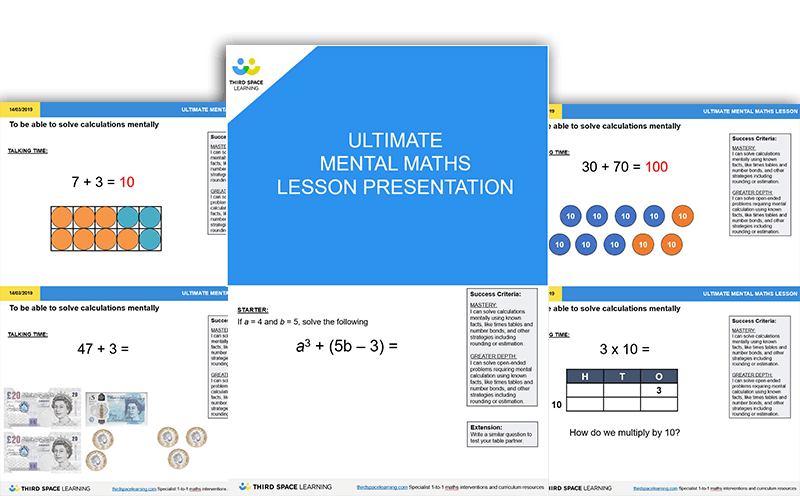Nail Your Number Facts With This 3 Minute Maths Activity [VIDEO]
You may not realise it but helping your child to nail their number facts is one of the most useful things that you can do to support them with maths at home. And here, we have the ideal 3 minute maths activity to make it fast and fun.
Number facts are a crucial part of early maths development in children aged between 5 and 11, so it is very important that your child has them by heart at an early stage!
What are number facts?
Number facts are early stage addition, subtraction, multiplication and division calculations that children should be able to recall easily and off by heart.
Every child, from Year 1 up to Year 6 and beyond, needs to be able to instantly recall some key number facts as this is an important thing to be able to do in primary maths.
- Years 1 & 2 – Children will start with learning number bonds to ten (1 + 9 = 10, 2 + 8 = 10), and then progress to learning number bonds up to 20
- Years 3 & 4 – Children will be expected to know their times tables from 1-12
- Years 5 & 6 – By this stage, all sorts of conversions should be known ‘just like that’ (e.g. 1km = 1000m, 0.25 = ¼ and others).
Why do children need number facts?
Quite simply the reason for your child to know the number facts for their age, is it just makes it easier for them to learn new information and strategies in maths.
Children’s working memories (and ours for that matter!) have only a finite capacity, meaning the more they can commit to their long term memory, the better.

If they can learn their number facts to a state of ‘automaticity’ i.e. they can automatically recall them within 5 seconds without counting or ‘thinking’, it frees up their brain capacity to learn the new concept that’s being taught.
A good example of this is fractions. Learning about fractions with the numerator (number on the top) and denominator (number on the bottom) and how they work when adding, multiplying or anything else is hard for children.
Many struggle!
The Ultimate Mental Maths Lesson Powerpoint
Download this FREE ultimate mental maths lesson powerpoint, containing over 200 slides to ensure that you have everything you need to teach your class the mental maths strategies they need to excel!
Download Free Now!By making sure your child, in this instance, knows their times tables, once they start to learn about fractions, they can focus all their attention on working out the strategy needed, rather than on working out the answer.
Moreover, once your child is in Year 6, one of the SATs Maths papers they will sit is an Arithmetic paper, and if they don’t have some of their number facts on instant recall they will not be able to complete it in the given 30 minutes, making it very difficult to get through all 36 questions!
How to help your child learn their number facts
There are lots of different ways to help your child learn their number facts, and some are certainly more fun than others!
When teaching a topic, the aim is that your child enjoys the process, takes ownership of their own learning, and can see the progress they’re making. We know that this is easier said than done, and that is why we are here to provide guidance using our years of maths teaching knowledge!
Which number facts to learn
Start with the following KS1 Number Facts :
- Doubles up to 10
- Doubles up to 20
- Number bonds to 5
- Number bonds to 10
- Ten and over
- Bridging over 10
- Number bonds to 20

Now that we have answered the question “What are number facts?”, and given you a place to begin with your child, it’s time to share with you our favourite number facts game that you can play at home.
As teachers we know how tricky it can be to find engaging ways to use maths when school is finished for the day, but our maths facts game has proven popular amongst students in schools across the land so we are sure it will be the same in your home!
Number facts activity: 3 minute maths paper flip
Either you or your child can start by making and writing on the paper flip. The process is very simple, as is explained in our video above.
How to make your number facts paper flip
- Get an A4 piece of paper.
- Fold it in half lengthwise. And again.
- Cut along a fold to create a strip.
- Concertina that strip of paper.
- Write a calculation without an answer on the top fold.
- Flip the paper over and write the calculation with the answer on the reverse.
- Continue down the flipping the back back and forth repeating with different calculations and answers on the reverse.
Once the number facts paper flip has been created, the following step-by-step instructions can be issued to your child to enable them to learn their number facts with their new resource!
How to use your number facts paper flip
Now you are ready to start turning your calculations into number facts.
- Pick up the strip and look at the top calculation (the one without an answer).
- Working it out if necessary, say the answer.
- Flip the strip to check.
- Move down the calculations and repeat.
- When at the bottom, grab a different strip. Repeat. Go back to the first strip.
- Repeat 5 minutes later.
- And that’s it. Number facts nailed in 10 minutes!
How to know which number facts your child needs more or less help on
To find out which number facts you should focus on, start with doubles up to 10 (1+1, 2+2, 3+3 etc) from the list above and find out where your child’s gaps are.
A gap is any fact that is not said correctly within 5 seconds.
It is easier for your child to view the calculation rather than hear it, so write down the calculation on paper and get them to say it out loud within 5 seconds.
Move down the list of number facts till you find their gaps – that’s what to put on the paper flip!
The key is keeping things simple. Stick to the set your child has gaps in until those gaps are answered correctly, day after day.
Keep revisiting the same calculations by reusing the same strips.
Stick to addition, certainly until almost all the sets are secure. Then, later on, as you progress, you can move on to subtraction, which is the opposite operation to addition.
Children learn this at school as the ‘inverse operation’, so if they have come home mentioning this, you now know what they mean!
For example, if you know 3 + 6 = 9 as a fact, you also have the basis of knowing 9 – 3 = 6 and 9 – 6 = 3.

How to make number facts easier
If your child is struggling to retain or calculate, it is a good idea to represent the calculation visually.
At school we use something called a tens frame which you can easily scribble on a piece of paper to help them.

You’ll need 2 ten frames together for numbers over 10.
If they are still finding it difficult, resorting to counting is absolutely fine until your child has an idea about what the answer could be. This will usually come from remembering the saame calculation or learning a strategy that limits the need for counting.
How to make number facts harder
If your child needs to be challenged, instead of the usual format of a calculation, put a square where a number should be, e.g. 4 + 7 = [ ]. This can be moved around so switch it up!
[ ] = 4 + 7
4 + [ ] = 11
[ ] + 7 = 11 etc.
If a child knows 2 + 3 is 5, they can work out 12 + 3 = 15 using that fact. It shouldn’t be a big leap for them to apply that same understanding to work out 42 + 3 or 72 + 3. And in turn, that should support 42 + 23 and 72 + 13.
Strips could move to purely focusing on these links that can be made.
Older children could then use the same principle to make strips for a times table such a 6x 7x 8x whatever times table is being learnt. Alternatively they could use the strips to show frequently used fractions, decimals and percentages.
The possibilities are endless with these strips, and you are only limited by your imagination. But if you’re looking for even more ways to challenge your children, we have plenty in our list of home learning resources.
When and where to use this number facts activity
When – Every day for at least 5 minutes. Once you have spent 10 or so minutes making the strips, all you need is a spare few minutes throughout the day to use them.
Where – Anywhere! The car, the breakfast table, after school club. Walking to school? Ditch the strips and use the same principle. Revisit the same calculations. Limit how many are being spoken rather than written and and pick them from all from the same ‘set’ described above.
Once you are used to the strips, you will begin to use the principle in fun and creative ways.
Extra tips to encourage number fact recall at home
When working with your child, encouragement is the name of the game.
Gentle ‘we just saw that one a couple of minutes ago, can you think back…’ and ‘if you are stuck between a couple of answers, just go for it, it doesn’t matter if you are wrong’ will help nudge children towards retaining that information the next time.
In other words, the goal is to help them move away from relying on counting. It is counterproductive to put them under pressure ‘You know this, we just did it, come on!’ type comments are not going to help anyone here – brains close off at this point and 1+1 becomes too difficult to comprehend as a result!
In the classroom we use something referred to as growth mindset to encourage the learning of new methods and topics.
DO YOU HAVE STUDENTS WHO NEED MORE SUPPORT IN MATHS?
Every week Third Space Learning’s specialist school tutors support thousands of students across hundreds of schools with weekly online 1 to 1 maths lessons designed to plug gaps and boost progress.
Since 2013 these personalised one to one lessons have helped over 150,000 primary and secondary students become more confident, able mathematicians.
Learn how the tutoring integrates with your SEF and Ofsted planning or request a personalised quote for your school to speak to us about your school’s needs and how we can help.





